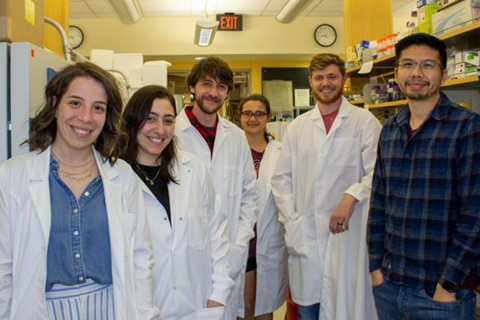Bryan Hsu, an assistant professor of biological sciences at Virginia Tech, has received a five-year $1.9 million Maximizing Investigators’ Research Award from the National Institute of General Medical Sciences to develop a model to test the role of lytic bacteriophages, or phages as they are commonly called, in the mammalian gut.

“We think there is some kind of role of phages in the gut, and it is really hard to study because everything is linked,” said Hsu, also a faculty affiliate of the Center for Emerging Zoonotic and Arthropod-borne Pathogens. “Normally phages and bacteria are intrinsically linked because you have this constant infection process, and it’s really hard to separate the phage particles and bacterial cells.”
Many organisms living inside the human body contribute to a healthy gut microbiome, one of which is a virome — a community of phages. These phages are viruses that invade bacterial cells. There are two types: lytic phages that replicate and kill the bacteria cell and temperate phages that hide within it. These phages only infect bacterial cells, but scientists know little more about their actual role in the human gut.
Removing phages
Hsu and his team of researchers in the College of Science plan to remove lytic phages without affecting the bacteria inside a mammalian gut. This has been done in a culture dish but it has not been done inside a mammal.
“We will not only deplete the viral community, but also replenish it to see if it comes back, to see if we can reconstitute the phage community,” said Hsu. “There have been a lot of correlations between the gut biome and disease. You see different compositions of viruses so there are hints that there is a relationship there, or there’s some kind of health impact. But how it happens is an open question.”
Gut microbiomes are generally specific to individual mammals, but when mice are housed together, sharing a cage and bedding contributes to similar microbiomes. Hsu’s team will work with two groups of such mice. One group will go through phage depletion protocol and then will be given phages extracted from another group via fecal transplants.
Fecal virome transplants
“Real-world application would be fecal virome transplants, just like fecal microbiota transplants except with just the phage part,” said Hsu.
Fecal microbiota transplantations are the delivery of a healthy human donor stool to another person via enema, colonoscopy, or capsule. They are generally given for debilitating gastrointestinal infections, such as recurrent Clostridioides difficile infection, but the procedure isn’t perfect. Bacteria with antibiotic resistant qualities or pathogenic bacteria can be accidentally transplanted.
“Usually screens are supposed to catch this, but sometimes they don’t,” Hsu said.
Viral influence
Hsu pointed to one small study in which the bacteria from the stool transplant was filtered out, yet the fecal microbiota transplants were still successful in treating recurrent Clostridioides difficile infection. While the results are only suggestive, they point to the possibility that bacteria are not the only important component in a healthy gut microbiome.
Hsu believes that phages could have played a role in those successful outcomes, as well as other outcomes, by having a positive impact on the overall bacterial community.
Phages may also help with the growing number of drug-resistant bacteria. In an experimental treatment in 2016 at the University of California, San Diego, doctors successfully used phages to treat a patient with organ failure from an antibiotic resistant bacteria.
Research using these phages to fight drug-resistant bacteria is expanding, but the big picture, the actual role of the phages in the mammalian gut, is still not well known.
“There’s no good model to study it, and that’s what I propose to do,” Hsu said.







No comments yet